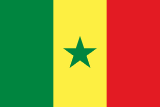
Senegal
Parliamentary Election, 17 November 2024
Floods, October–November 2024
In early November 2024, the Senegal and Gambia rivers overflowed their banks, causing severe flooding. The deluge was driven by relentless torrential rains throughout October. Villages located near the rivers were submerged in water, with the regions of Tambacounda, Matam, Kedougou and Saint Louis being the most affected. The floods led to public buildings such as schools and health centres having to shut down, and displacement of over 56,000 people following damage to homes and agriculture (Chemam 2024). By 4 November, over 18,000 children were estimated to be impacted by school closures. Emergency relief efforts included food supplies, hygiene kits, temporary housing and shelters (UNICEF 2024). The torrential rain that caused the flooding has been recognized as a result of climate change (UNICEF 2024).
Impact on the electoral process
Senegal held snap elections on 17 November 2024, after President Faye dissolved parliament in September (IFES n.d.). President Faye visited the flood-affected regions ahead of the elections (Chemam 2024). The National Fire Brigade and the Directorate of Civil Protection worked with the General Director of Elections (DGE) to avert disenfranchisement among the displaced. The DGE further collaborated with local authorities to support voting infrastructure and logistics such as transport of results (Gueye 2024).
Residents of Korkadié, in northern Senegal, were shuttled by boat to polling stations by firefighters. The same procedures were used to ensure that electoral staff and observers could access polling stations in Diama Alwaly (APS 2024).
Local electoral committees oversaw polling stations that were in at-risk areas or relocated, ensuring clear communication with voters. Signs were placed at former polling sites to guide voters to their new locations. To enhance accessibility, the DGE revamped its website for easier navigation and established a WhatsApp group for candidates’ representatives (Gueye 2024).
Turnout was 49.27 per cent, as compared with 46.64 per cent in the previous parliamentary election (2022) and 61.3 per cent in the recent presidential election (March 2024) (International IDEA n.d.).
APS, ‘Podor: des déplacés de la crue du fleuve Sénégal ont pu voter (préfet)’ [Podor: people displaced by the flooding of the Senegal River were able to vote (prefect)], 17 November 2024, < https://aps.sn/podor-des-deplaces-de-la-crue-du-fleuve-senegal-ont-pu-voter-prefet/ >, accessed 12 October 2025
Chemam, M. ‘Senegal: Unprecedented Floods Devastate Harvests in Northeastern Senegal’, RFI/All Africa, 11 November 2024, < https://allafrica.com/stories/202411110568.html# >, accessed 12 October 2025
Gueye, T. ‘Vote pour les Législatives : Ce qui est prévu pour les électeurs touchés par les crues du fleuve Sénégal’ [Legislative election: What is planned for voters affected by the flooding of the Senegal River], Sene News, < https://www.senenews.com/actualites/vote-pour-les-legislatives-ce-qui-est-prevu-pour-les-electeurs-touches-par-les-crues-du-fleuve-senegal_514615.html >, accessed 12 October 2025
International Foundation for Electoral Systems [IFES], Election Snapshot – ‘Elections in Senegal: 2024 Snap Legislative Elections’, [n.d.], <https://www.ifes.org/tools-resources/election-snapshots/elections-senegal-2024-snap-legislative-elections>, accessed 12 October 2025
International IDEA, Voter Turnout Database – ‘Senegal’, [n.d.], <https://www.idea.int/data-tools/data/country?country=197&database_theme=293>, accessed 12 October 2025
UNICEF, ‘Senegal Floods Flash Update #1’, 4 November 2024, <https://www.unicef.org/media/164531/file/Senegal-Flash-Update-Floods-October-2024.pdf>, accessed 12 October 2025